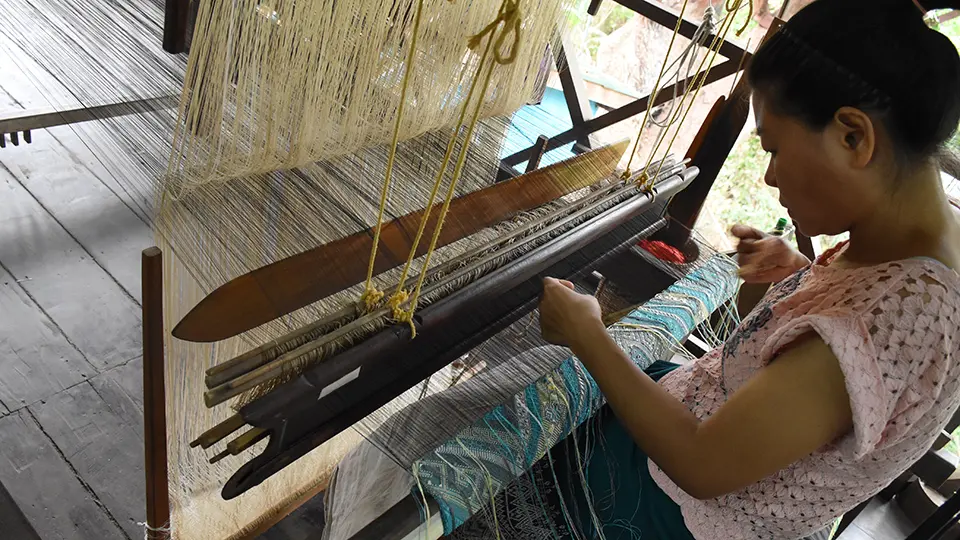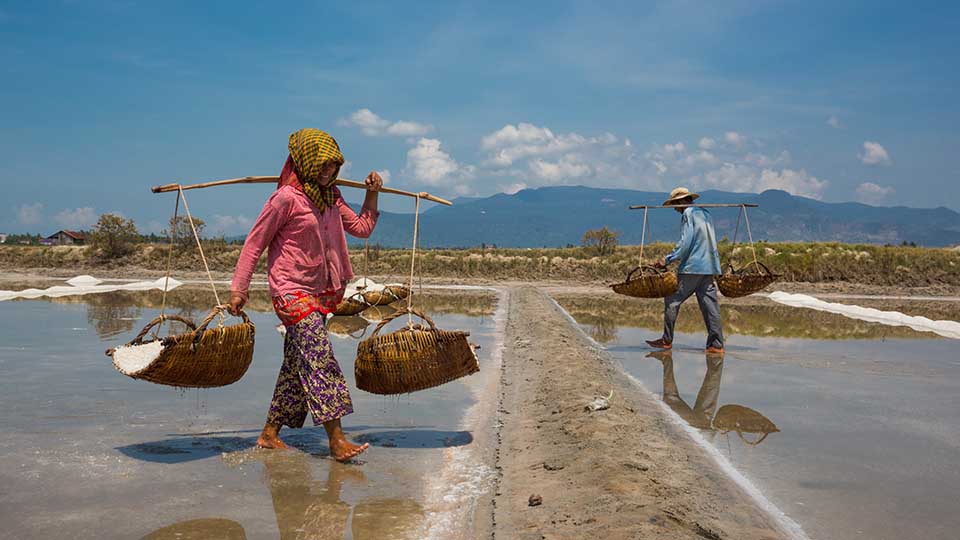Cultural Heritage Kept Alive Through Precious Hand-Woven GI Silk in Laos
At the heart of Luang Prabang, one of the oldest provinces of Laos, silk-making keeps ancestral knowledge and skills alive. "Luang Prabang Silk,” a registered geographical indication, brings additional revenue to weavers and job prospects for women in rural areas.

Mrs. Somchith Chaleunphonh was born in Xangkhong Village, Luang Prabang district, and has lived there ever since. She was 11 years old when her mother taught her the art of weaving.
Now 66, she is the President of the "Luang Prabang Silk" Promotion Association, created in September 2020, shortly before the GI registration.
She describes "Luang Prabang Silk," produced since times immemorial, over many generations of women, as shiny, soft, smooth, and supple.
Ancestral Lao Silk-Weaving Process
"Luang Prabang Silk" follows a production cycle free of synthetic fertilizers and pesticides, and only uses local natural dyes, she said.
Silk yarns are produced locally from native silkworms (MonNoy) and mulberry trees. Farmers propagate the trees using cuttings that flourish in the fertile soil of Luang Prabang Province.
She explained that the hand reeling makes the silk particularly soft and very different from factory-produced silk.
One key to the smoothness of "Luang Prabang Silk" is degumming: removing the gum from raw silk. The silk is boiled in an alkaline solution, leaving the silk soft and lustrous.
Lao Traditional Patterns with Designs Inspired by Nature
"Luang Prabang Silk" can be plain woven but can also be weaved in intricate, beautiful, and colorful traditional designs and patterns that include ancient symbols, such as temples, birds, mythical serpents (Naga), elephants, other animals, and flowers.
Nowadays, designers use old and new concepts for their creations, noted the association’s President.

Natural Silk Fabric Dye with a Rainbow of Plant-Based colors
Producers of "Luang Prabang Silk" use a variety of extracts from local plants, such as Horm (indigo blue and light green), annatto seeds (orange and yellow), and rosewood bark to dye the silk.
Depending on the desired color, the "Luang Prabang Silk" is dyed using a hot or cold dyeing process. For red, Mrs. Chaleunphonh explained, “the rosewood bark is smashed and soaked in water for three to four days. The preparation is then boiled until the water turns dark red.” Shikakai (small climbing shrub) is added to the filtered water and the silk, and left to simmer until the silk has turned red. She added that dark blue is obtained with indigo and only requires a cold soak.
Silk Weaving, A Source of Livelihood for Weavers in Luang Prabang
Mrs. Chaleunphonh noted that some weavers rely on their weaving for their sole income. “Others are farmers and weave as a side job whenever they have free time, and some are government workers who weave during their spare time,” she said.

Mrs. Khamchan Khoudthao is 52 and a member of the association. She weaves for a local brand and lives in Naxang Village in the Luang Prabang District. Weaving “Luang Prabang Silk” is her sole revenue.
She started weaving when she was ten and learned the skill from her mother. Weaving a piece of fabric of 1,8 meters x 50 cm takes her about two weeks, and the shop pays her by the piece. Her best advice for meeting the daily challenges of occasional tangled silk and intricate designs is to be calm and patient.

The association has 48 members, 40 of which are women who sometimes have their own members. Members weave “Luang Prabang Silk” and regular silk.
Weavers produce skirts, scarves, shawls, and home decorations like wall hangings. In 2023, the association's members produced some 400 pieces of the GI silk.
Raising awareness about Geographical Indications in Laos
GI silk products are sold in five shops in Luang Prabang City and the Nambak district in the Luang Prabang Province.
Some local shops are trying to promote GI silk products through local events and online platforms, such as Facebook, Mrs. Chaleunphonh said.
But, according to her, there is a need for awareness raising about GIs in Laos, particularly in advertising the quality of GI products on social networks, TV, radio, and billboards. Even the association's members need to understand the added value of GIs better, she said.
Better Marketing Price, Sustaining Cultural Heritage
The “Luang Prabang Silk” is more expensive to produce, bringing the market prices up to some 30 %, said Mrs. Chaleunphonh.
According to Mrs. Khoudthao, weaving the “Luang Prabang Silk” increased her revenue and she finds that the GI silk is attracting more customers.
"Weaving ‘Luang Prabrang Silk,’ I feel I am sustaining its cultural heritage and sharing it with others," she said.

Expanding cultivation and Attracting Younger Generations
With the growing interest for "Luang Prabang Silk," Mrs Chaleunphonh said the limited area of mulberry farming is restraining the production increase and advocated for an extension of the mulberry cultivation.
She wishes to attract younger generations in remote areas to start weaving and wants to attract non-GI weavers to join the association and start weaving “Luang Prabang Silk”, so that in the next five years, the production meets the market demand.
WIPO is supporting the silk producers and their silk promotion association through a tailored project designed to enhance their capacity to use and manage GI effectively, expand markets for their products, and forge new business partnerships. Furthermore, the project will contribute to developing local GI expertise to support more GI producers sustainably.


